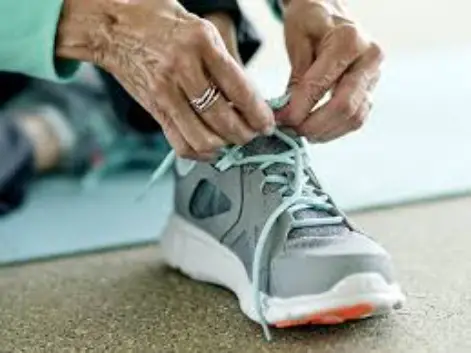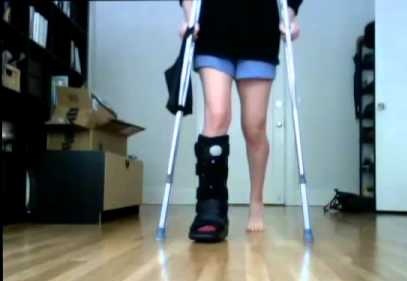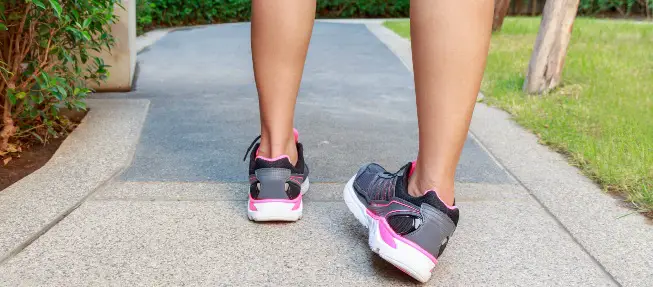
As an athlete or a trail runner, you always wanted your shoes to feel like an extension of your feet — not a blister factory plotting against your ankles.
But we’ve all been there: that sharp sting at the back of your heel, the slow burn that turns every step into a reminder that something’s off.
The truth is, even the best shoes can betray you if they’re not broken in or fitted right. Before you toss them aside or reach for another band-aid, let’s fix the root of the problem.
Here in this guide, we will discuss smart (and sanity-saving) tips to stop your shoes from rubbing your ankle back — so you can focus on your stride, not your sores.
Sore Achilles from a Shoe Rubbing
The Achilles tendon is the strong band of tissue that connects your calf muscles to your heel bone — crucial for every stride, jump, or sprint you take.
But when your shoes don’t play nice, they can turn this powerhouse into a sore spot.
Friction and pressure from stiff or poorly fitting shoes can rub directly against the Achilles, causing regular irritation. Over time, worn-out shoes or their soles can also lead to issues like:
- Achilles bursitis – inflammation of the tiny fluid-filled sac (bursa) that cushions the tendon, leading to pain, redness, and swelling.
- Achilles tendinitis – when rigid-backed shoes put repeated stress on the tendon, causing it to become inflamed and sore.
Even certain footwear, like high heels or shoes with hard heel supports, can make things worse by pressing soft tissue against stiff edges — sometimes resulting in a painful bump or Haglund’s deformity (pump bump).
So, while it might seem like “just a bit of rubbing,” ignoring it can turn a minor shoe issue into a painful Achilles problem — one that sidelines you longer than you’d like.
But what can you do to prevent the shoes from hurting the back of your feet? Let’s take a look…

13 Tips To Stop Your Shoes From Rubbing Your Achilles
Fortunately, there are ways through which you can stop shoes from rubbing or biting your ankle back. These are as follows:
1- Wear Double Socks
Wear your normal socks over a pair of ankle socks. This simple layering trick works because the two socks rub against each other — instead of your shoe rubbing directly against your skin.
The result will be less friction, fewer blisters, and much happier heels.
I know wearing the two socks can be difficult for many. But if you choose the right fit and size, these can be properly worn without slipping into one another.
Go for lightweight, moisture-wicking socks that fit snugly without being tight. When sized properly, they’ll stay in place without sliding or bunching, giving you smooth protection and a friction-free run.
2- Make Use of Heat
Put on a pair of woolen or thick socks and wear your shoes. Now blow a hairdryer on medium and heat your shoes back till they get a little malleable.
As you move your feet, the warm material will accordingly get molded to fit the shape of your heel in a better way. It works great for suede, cloth, and leather shoes.
However, ensure you don’t bring the dryer too close to the shoes for a long time, or it may melt or burn the shoes.
3- Make Use of Duct Tape
If you need something that lasts even when you run or hike with your shoes, then prep your heels or shoes with duct tape to lower the friction and rubbing.
Care that you do not use them if you already have blisters. It may hurt instead of making everything right.
You can also find plenty of bandages and tapes at pharmacies or sports stores.
If you want, you can choose one that’s athlete-grade and made from breathable, flexible fabric — it’ll stay in place better and keep your skin comfortable while you move.
4- Use Anti-Friction Stick
An Anti-Friction Stick (also known as an anti-chafing stick or anti-blister balm) is a simple yet game-changing tool for anyone tired of sore heels.
It’s hypoallergenic, unscented, and gentle on the delicate skin around your ankle, making it safe even for daily use.
The stick contains a smooth balm that you can apply directly to the back of your ankle or any area prone to rubbing.
Once applied, it forms an invisible, protective barrier between your skin and the shoe. This barrier reduces friction, heat, and moisture buildup, which are the main culprits behind blisters and irritation.
Light, non-greasy, and easy to carry, an anti-friction stick is perfect to keep in your gym bag or travel kit — a small swipe can save you from a day of painful rubbing and ruined runs.
5- Ensure Your Shoes Fit Well
Your ill-fitting shoes can be a cause of various foot problems. The rubbing of shoes around your heels, Achilles, and back of your ankle bone is one of the most common.
Shoes that are too big can cause your feet to move around inside them all day. This can cause friction and hence blisters.
Shoes that are too small/tight will also cramp your feet, leading to blisters and pain.
Hence, ensure that you choose the premium quality boots or shoes of the right size for your feet.
6- Get Your Shoe Checked with a Cobbler
If you can’t part with your favorite pair just yet, take them to a professional cobbler or shoe repair shop every few months for a quick check-up.
They can reshape, stretch, or pad areas that are causing friction, ensuring your shoes fit comfortably and last longer.
For leather shoes, regular conditioning also makes a big difference. Your cobbler can apply a thin layer of leather oil, petroleum jelly, or rubbing alcohol to soften stiff areas that might rub against your heel.
Make sure you let it dry completely before wearing.
Doing this after cleaning and drying your shoes — and repeating it every few months — keeps the leather supple, reduces friction, and helps prevent those painful heel rubs.
7- Get The Right Fit with Insoles
Shoes that are too big can be easily fixed by adding a custom insole for your shoes. They bring a little lift to your foot and lower the surface area, which is in contact with the heel.
Insoles also offer a slightly tighter fit, which lowers the movement between the skin and shoe, thereby reducing the chances of the formation of blisters. They also make your shoes more supportive and comfier!
8- Use a Heel Gripper or Heel Cup
If you’re still struggling with shoes rubbing the back of your ankles, a heel gripper or heel cup can help protect heels from shoe rubbing and add extra comfort.
A heel gripper is a small strip of foam, suede, or rubber that sticks inside your shoe’s heel area to hold your foot securely in place.
It prevents slipping and reduces friction that often causes blisters or soreness—an easy way to fix shoes that rub your heel.
A heel cup, on the other hand, sits inside the shoe under your heel to add cushioning and absorb shock.
Gel heel cups are especially useful if you want to stop boots from rubbing your heels or need extra support during long walks.
Both are inexpensive, easy-to-use solutions that can make a big difference in comfort and help your shoes fit better without irritation.
9- Use an Achilles Tendon Sleeve for Protection
If you’re prone to Achilles tendon pain, strain, or minor injuries, wearing an Achilles tendon sleeve can provide valuable protection and support.
These specially designed compression sleeves gently hug the tendon area, improving blood circulation and reducing pressure caused by shoes or physical activity.
An Achilles sleeve helps soothe soreness, speed up recovery, and prevent further irritation—especially useful if you’ve had issues with tight shoes or intense workouts.
It also acts as a protective layer between your skin and the shoe, minimizing friction that can lead to blisters or rubbing.
For those recovering from Achilles tendonitis or who want to avoid re-injury, this sleeve can be an effective daily support tool to keep your heels and tendons safe and comfortable.
10- Apply Some Cream or Ointment
If your shoes rubbed the skin off your heel or the back of your heel is rubbed raw, applying a soothing cream or ointment can help protect and heal the area.
Friction from tight or stiff shoes can easily irritate delicate skin, and treating it early prevents further damage or infection.
Use a healing ointment or anti-friction balm to create a protective barrier between your skin and the shoe.
Products containing ingredients like aloe vera, shea butter, or petroleum jelly can help moisturize the skin and reduce irritation.
For deeper soreness or redness, a medicated cream with antiseptic or anti-inflammatory properties can promote faster healing.
Apply the cream before putting on your shoes to reduce rubbing and again afterward to help your skin recover.
Until the area heals, consider wearing softer footwear or adding padding around the heel to avoid reopening the wound.
11- Adjust Your Routine and Give Your Feet a Breather
If your shoes are rubbing against your Achilles and causing pain, that’s your body waving a red flag. It’s time to adjust your routine before a minor irritation turns into a real injury.
This might mean taking a short break from running or high-impact workouts, or switching to shoes with a softer, more flexible heel until the area recovers.
Make it a habit to pause and rest regularly during physical activity. The moment you feel rubbing or soreness, stop and let your feet breathe.
A few mindful breaks can do wonders — easing inflammation, preventing further strain, and helping you bounce back stronger and more comfortably.
12- Tape the Bottom of Your Shoe and Walk Slowly
If your shoes are still rubbing against your heel and nothing else has worked, try taping the bottom edge of your shoe.
This creates a small barrier between the shoe and your Achilles tendon, reducing friction.
Cut a strip of tape to fit neatly around the heel area and press it down firmly. It might not look perfect, but it can offer quick relief.
Once you’ve done that, walk around slowly to help the shoe adjust to your foot. Gentle movement allows the material to loosen and mold to your shape over time.
You can also wiggle your toes a bit to improve comfort. The more you wear the shoes gradually, the better they’ll break in—and the less they’ll rub against your heel.
13- Visit a Foot Specialist for Heel Blisters and Achilles Discomfort
If your shoes keep rubbing against your Achilles tendon or you’re dealing with recurring heel blisters, soreness, or raw skin around the ankles, it’s important to take it seriously.
What may seem like a small irritation can quickly turn into a painful condition that affects how you walk, stand, or even rest.
Persistent friction can lead to inflammation, swelling, or conditions such as Achilles tendinitis, bursitis, or cracked skin that’s prone to infection.
A foot specialist (podiatrist) can help identify the exact cause of your discomfort.
Sometimes the issue isn’t just the shoe—it could be your foot structure, the way you walk, or even muscle tightness in your calves or Achilles.
During the consultation, the specialist may examine your gait, check for signs of pressure points, and suggest tailored solutions such as custom orthotic insoles, heel pads, anti-friction patches, or physiotherapy exercises to strengthen your feet and lower legs.
They can also guide you in choosing shoes that properly support your arch and heel, ensuring that your footwear works with your feet—not against them.
In more serious cases, a podiatrist may recommend specific treatments, dressings, or medications to reduce inflammation and promote healing.
How to Use Moleskin to Prevent Blisters On the Back Of the Heel?
Moleskin is typically a thin (but strong) fabric that is made of cotton material. It has a soft surface on one side and a sticky adhesive on the other.
Using Moleskin is one of the best things you can do to prevent blisters from forming on your ankle bone back due to the regular cutting/rubbing of new shoes.
Moleskin to protect a blister from irritation and make your shoes fit better can be applied in two ways:
1- Sticking on the inside of your shoes
For sticking a Moleskin inside your shoes, you need to unroll the section and place it inside the heel of your shoe.
Now trace the area (of Moleskin) you want to cover with a pen or pencil. Using sharp scissors, cut the shape and peel back the protective backing on the moleskin section.
Now clean the dust of dirt (if any) inside the shoe and stick this piece inside the heel of your shoe.
2- Sticking it on your heels for protection
The second way to prevent the blisters from forming is by applying the Moleskin to your heel skin directly.
First of all, clean up the skin on your heel properly and make it completely dry using a soft cotton towel.
Now, using a scissor, cut a piece of moleskin section that is large enough to cover your heel.
After removing the protective backing, stick the moleskin to your heel. It works as simple as a band-aid to protect your heels from rubbing.
Now, before wearing the shoes, make sure that you wear thin ankle socks that will help keep the moleskin in place and can provide extra protection.
Key Factors to Check Before Buying Shoes That Won’t Rub Your Achilles
We’ve all been there — you slip into a new pair of shoes that look perfect, only to realize they’re secretly plotting against your Achilles tendon.
That raw, burning feeling at the back of your heel? It’s not just annoying — it’s your body’s way of saying, “These shoes weren’t made for walking.”
The good news: a few smart considerations before buying can save you from that painful mistake. Here’s what to keep in mind when choosing shoes that love your feet back — especially your Achilles.
1- Heel Collar Padding
Look for shoes with soft, cushioned collars around the heel.
A well-padded collar acts like a buffer between your skin and the shoe’s edge, reducing friction where rubbing often starts. If it feels stiff or scratchy in the store, it’ll be merciless after a few miles.
2- Heel Counter Flexibility
That firm cup at the back of your shoe (the heel counter) should hold your foot steady — but not dig into it. Too rigid, and it’ll chafe your Achilles; too soft, and your foot slides around.
The sweet spot? A structured yet slightly flexible counter that supports movement without irritation.
3- Proper Heel Fit
If your heel lifts every time you walk, you’re in for trouble. Shoes that fit snugly at the heel prevent unnecessary motion — and therefore, friction.
Try the “finger test”: you should barely fit one finger between your heel and the shoe when laced up.
4- Back Height and Shape
Some shoes ride too high on the heel, pressing right into your Achilles tendon. Others slope awkwardly and create a rubbing hotspot.
Ideally, pick a pair of boots with a slightly curved or dipped back design — it gives your Achilles room to move freely while avoiding rubbing back of the heel.
5- Material and Inner Lining
Synthetic linings can be rough and trap heat, making friction worse. Natural, breathable materials like leather or soft mesh reduce moisture and allow your skin to glide smoothly rather than scrape.
Bonus: they tend to age more gracefully, too.
6- Break-In Behavior
Shoes that demand a long “break-in” period are basically telling you they’re not very kind.
Modern shoes with adaptive foams or flexible uppers should feel comfortable almost immediately. If they hurt on day one, chances are they’ll hurt on day ten.
7- Sock Compatibility
Even the best shoe can turn villainous if paired with the wrong socks. Choose moisture-wicking, cushioned socks that complement your shoe’s interior.
Avoid thick seams at the back — they’re the friction magnets you never asked for.
Final Thoughts
When shoes rub the back of your ankle, it’s more than just a comfort issue — it’s a signal that your footwear and your feet are not on the same page. The right pair shouldn’t demand bandages, blisters, or “break-in suffering.”
By applying the above simple yet effective tips — from choosing the right fit and materials to adding small protection hacks — you can turn painful steps into effortless strides. Remember, comfort isn’t a luxury; it’s the foundation of confident walking.
Your shoes should move with you, not against you. Treat your feet kindly, and they’ll carry you miles without complaint.




